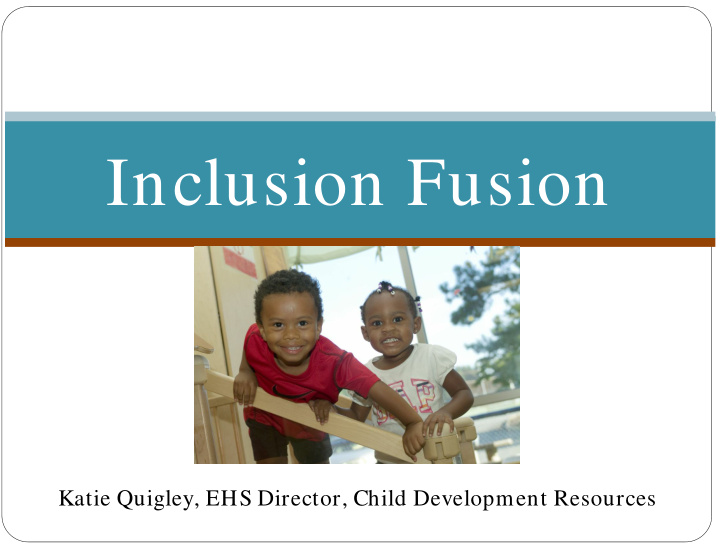



Inclusion Fusion Katie Quigley, EHS Director, Child Development Resources 1
Introduction Presenter Pre-Training Knowledge Measure Back Home Plan 2
Learning Objectives Use “People First” language to ensure positive, inclusive environments that respect all individuals Discuss the in’s and out’s of IDEA and ADA 3
Learning Objectives (continued) Understand the significance of successful communication with families and why it is so important Learn common modifications to support universal design and individualization for inclusive group care 4
People First Language “ Som etim es I w ish people w ould talk to m e first, before they ask w hat’s w rong w ith m e or w hat happened to m e. It m akes m e feel as though m y w heelchair is m ore im portant than I am . ” Jade Calegory: 1987 Easter Seal Acting Scholarship Winner 5
Benefits Brainstorm What are the benefits of inclusion for: ● Children with disabilities or special needs ● Children who are typically developing ● Parents and family members ● Teachers and caregivers ● The community 6
Alphabet Soup IDEA Part B Part C ADA The only disability is having no relationships ~ Judith Snow 7
Confidentiality The handling of knowledge that is privileged and confidential 8
Aspects of Confidentiality Activity Trust Ethics Legalities 9
Open Doors and Open Hearts Access for children w ith disabilities to the w orld of child care involves opening our hearts as w ell as our doors. Project EXCEPTIONAL 10
Universal Design vs. Individualization Universal design is borrowed from the movement in architecture to design buildings and products that accommodate a variety of users, including those with disabilities Individualization is when you make adaptations to materials to meet the needs of one individual 11
Inclusive Group Care Learning styles Absence of barriers Child-focused There is alw ays one m om ent in childhood w hen the door opens and lets the future in. Graham Greene 12
Common Modifications ● Environmental support ● Material adaptation ● Activity simplification ● Child preferences ● Special equipment ● Adult support ● Invisible support 13
Classroom Design 14
Summary 15
Resources Able Play: Play products for children with special needs – www.ableplay.org Beginning Together: Caring for Infants and Toddlers with Disabilities and Special Needs in Inclusive Settings (PITC Module V) – http:/ / cainclusion.org/ bt/ Disability is Natural - www.disabilityisnatural.com Program for Infant Toddler Care (PITC) – www.pitc.org/ pub U.S. Department of Labor: Disability Resources, Americans with Disabilities Act – www.dol.gov/ dol/ topic/ disability/ ada.htm U.S. Department of Justice: Commonly Asked Questions About Child Care Centers and the Americans with Disabilities Act – www.usdoj.gov/ crt/ ada/ childq%26a.htm 16
Co Concl nclusion Back Home Plan Evaluation 17
THANK YOU! Katie Quigley Child Development Resources Early Head Start Director katieq@cdr.org (757) 566-3300 18
Recommend
More recommend